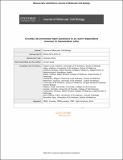Crumbs 3b promotes tight junctions in an ezrin-dependent manner in mammalian cells
Abstract
Crumbs3 (CRB3) is a component of epithelial junctions that has been implicated in apical-basal polarity, apical identity, apical stability, cell adhesion and cell growth. CRB3 undergoes alternative splicing to yield two variants: CRB3a and CRB3b. Here, we describe novel data demonstrating that as with previous studies on CRB3a, CRB3b also promotes the formation of tight junctions. However, significantly we demonstrate that the 4.1-ezrin-radixin-moesin (FERM) binding motif (FBM) of CRB3b is required for CRB3b functionality and that ezrin binds to the FBM of CRB3b. Furthermore, we show that ezrin contributes to CRB3b functionality and the correct distribution of tight junction proteins. We demonstrate that both CRB3 isoforms are required for the production of functionally mature tight junctions and also the localization of ezrin to the plasma membrane. Finally, we demonstrate that reduced CRB3b expression in head and neck squamous cell carcinoma (HNSCC) correlates with cytoplasmic ezrin, a biomarker for aggressive disease, and show evidence that whilst CRB3a expression has no effect, low CRB3b and high cytoplasmic ezrin expression combined may be prognostic for HNSCC.
Citation
Tilston-Lunel , A M , Haley , K , Schlecht , N , Wang , Y , Chatterton , A L D , Moleirinho , S L , Watson , A , Hundal , H , Prystowsky , M , Gunn-Moore , F J & Reynolds , P A 2016 , ' Crumbs 3b promotes tight junctions in an ezrin-dependent manner in mammalian cells ' , Journal of Molecular Cell Biology , vol. 8 , no. 5 , pp. 439-455 . https://doi.org/10.1093/jmcb/MJW020
Publication
Journal of Molecular Cell Biology
Status
Peer reviewed
ISSN
1674-2788Type
Journal article
Description
AMT-L is supported by the School of Biology, University of St Andrews. AMT-L, PAR and FJGM were funded by the Anonymous Trust, University of St Andrews. PAR is supported by the Melville Trust for the Care and Cure of Cancer. The mass spectrometry work was supported by the Wellcome Trust [grant number 094476/Z/10/Z], which funded the purchase of the TripleTOF 5600 mass spectrometer at the BSRC Mass Spectrometry and Proteomics Facility, University of St Andrews. The clinical study was supported by the Department of Pathology, Albert Einstein College of Medicine/ Montefiore Medical Center.Collections
Items in the St Andrews Research Repository are protected by copyright, with all rights reserved, unless otherwise indicated.

